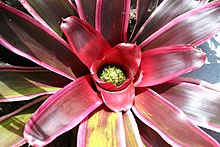Neoregelia
| Neoregelia | |
|---|---|

| |
| Neoregelia in bloom at a botanical garden. | |
| Scientific classification | |
| Kingdom: | Plantae |
| Clade: | Tracheophytes |
| Clade: | Angiosperms |
| Clade: | Monocots |
| Clade: | Commelinids |
| Order: | Poales |
| Family: | Bromeliaceae |
| Subfamily: | Bromelioideae |
| Genus: | Neoregelia L.B.Sm. |
| Subgenera | |
| Synonyms[1] | |
|
Regelia (Lem.) Lindm. 1890, illegitimate homonym, not Schauer 1843 nor H. Wendl. 1865 | |
Neoregelia is a genus of epiphytic flowering plants in the family Bromeliaceae, subfamily Bromelioideae, native to South American rainforests.[1] The genus name is for Eduard August von Regel, Director of St. Petersburg Botanic Gardens in Russia (1875–1892).[2]
Description
Neoregelias are epiphytic plants, meaning they grow attached to the branches of forest trees; they do not naturally grow in the Earth, though they can be cultivated on the ground in controlled conditions, such as a garden, provided they are kept in a very airy growing medium such as pine bark that allows the root system to breathe. Their roots serve primarily as hold-fasts to grip their canopy perches and are adapted poorly to absorb nutriment, which is instead obtained through leaf litter, animal droppings and rainfall that collects in the prominent central cup exhibited by most species in the genus. They have mostly broad, relatively flat leaves often marked brightly with red, purple or yellow pigments which serve to protect the green photosynthetic tissues from sunburn and through selective breeding and hybridization thousands of cultivars in almost all color combinations, many also striped with white, have been produced.
The inflorescences of these plants form in the shallow central depression - the "cup" - of the plant, which often fills partway with water, through which the flowers bloom. Neoregelias, like most bromeliads, bloom only once in their lifetime and then begin to die, but normally not before producing several pups - small clones of the parent plant - around the central flowering rosette on stolons.[3] These offshoots eventually replace the mother plant and form a cluster around it - although in cultivation, the offshoots can be severed and replanted when about two-thirds the size of the adult plant. The leaves immediately surrounding the inflorescence are very often brightly colored, even in species otherwise not brightly marked - an adaptation to attract pollinating insects.
Cultivation
Neoregelia bromeliads and their hybrids, due to their varied forms and beautiful colors, are commonly cultivated as houseplants, or in warm climates as landscape plants. They are particularly suitable for vivarium culture. Their needs are simple, mainly consisting of bright light (most forms will revert to green if lighting is sub-optimal) and an airy growing medium - some species do not do well in soil and will be prone to rot due to their nature as epiphytes.
In temperate regions where temperatures fall below 10 °C (50 °F), they must be grown under glass or as houseplants.[3] There are over 5000 registered cultivars.
Symbiosis
Neoregelias are utilized by many species of poison dart frog to reproduce. The frogs raise their tadpoles in the security of the water-filled cup in the bromeliads' rosettes, allowing them to stay in the relative safety of the treetops and not have to venture to a pool on the ground where predators are likely much more numerous. Waste products from the frogs and their offspring, once deposited into the cup, are utilized by the plant for nourishment.[4]
Subgenera
|
|
Species
Photo gallery
-
Neoregelia 'Perfection' plant
-
Neoregelia 'Perfection' closeup
-
Photo of a Neoregelia at the United States Botanic Garden.
-
Neoregelia pendula
-
Neoregelia 'Yellow Devil' flower emerging from submerged inflorescence.
References
- ^ a b Kew World Checklist of Selected Plant Families
- ^ "Archived copy". Archived from the original on 2007-02-03. Retrieved 2009-10-19.
{{cite web}}: CS1 maint: archived copy as title (link) - ^ a b RHS A-Z encyclopedia of garden plants. United Kingdom: Dorling Kindersley. 2008. p. 1136. ISBN 1405332964.
- ^ https://www.aqua.org/blog/2013/July/the-life-cycle-of-poison-dart-frogs-explained
External links
- BSI Genera Gallery photos





